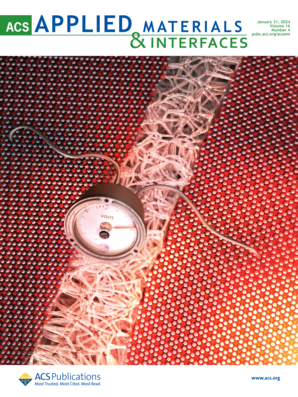利用薄膜模型系统揭示钙钛矿氧化物在电导率范围内的本征析氧反应活性
IF 8.3
2区 材料科学
Q1 MATERIALS SCIENCE, MULTIDISCIPLINARY
引用次数: 0
摘要
开发高效的水电解电催化剂是降低高过电位的必要条件,特别是在发生析氧反应(OER)的阳极。然而,建立催化剂设计规则以找到最佳的电催化剂是一个巨大的挑战。通常被认为是合适的OER催化剂的复合氧化物,其电导率值差异很大,这使得将内在催化活性与内部传输限制分开具有挑战性。在这里,我们使用系统的外延薄膜模型催化剂方法,系统地解耦了由体积电阻率、催化剂载体的接触电阻和内在OER催化性能引起的限制。研究了三种钙钛矿氧化物LaNiO3-δ (3.7 × 10-4 Ω cm)、La0.67Sr0.33MnO3-δ (2.7 × 10-3 Ω cm)和La0.6Ca0.4FeO3-δ (0.57 Ω·cm)的电阻率对催化活性的影响。我们通过比较绝缘衬底和导电衬底来调整电子通过催化剂体的途径。所述导电衬底将通过催化剂体的电子路径从毫米长度尺度减小到纳米长度尺度。正如我们所示,对于大电子路径,由于高度不均匀的横向电流密度分布,观察到的催化活性与电阻率有关。同时,即使在导电衬底(掺铌的SrTiO3)上,也会出现较大的接触电阻,限制了本然催化性能的测定。通过插入界面偶极层(在本例中为LaAlO3),我们解除了这些界面阻力,从而揭示了所有被检测催化剂的内在催化性能。我们发现La0.6Ca0.4FeO3-δ和LaNiO3-δ在0.1 mA/cm2时表现出相似的0.36 V的固有过电位,而它们的电阻率相差3个数量级。这一发现表明,优化OER催化剂的电子路径可以找到新的构效关系,即使电子电阻很高,也可以识别出高活性催化剂。本文章由计算机程序翻译,如有差异,请以英文原文为准。

Revealing the Intrinsic Oxygen Evolution Reaction Activity of Perovskite Oxides across Conductivity Ranges Using Thin Film Model Systems
The development of efficient electrocatalysts in water electrolysis is essential to decrease the high overpotentials, especially at the anode where the oxygen evolution reaction (OER) takes place. However, establishing catalyst design rules to find the optimal electrocatalysts is a substantial challenge. Complex oxides, which are often considered as suitable OER catalysts, can exhibit vastly different conductivity values, making it challenging to separate intrinsic catalytic activities from internal transport limitations. Here, we systematically decouple the limitations arising from electrical bulk resistivity, contact resistances to the catalyst support, and intrinsic OER catalytic properties using a systematic epitaxial thin film model catalyst approach. We investigate the influence of the resistivity of the three perovskite oxides LaNiO3-δ (3.7 × 10–4 Ω cm), La0.67Sr0.33MnO3-δ (2.7 × 10–3 Ω cm), and La0.6Ca0.4FeO3-δ (0.57 Ω·cm) on the observed catalytic activity. We tuned the electron pathway through the catalyst bulk by comparing insulating and conductive substrates. The conducting substrate reduces the electron pathway through the catalyst bulk from the millimeter to nanometer length scale. As we show, for the large electron pathways, the observed catalytic activity scales with resistivity because of a highly inhomogeneous lateral current density distribution. At the same time, even on the conducting substrate (Nb-doped SrTiO3), large contact resistances occur that limit the determination of intrinsic catalytic properties. By inserting interfacial dipole layers (in this case, LaAlO3) we lifted these interface resistances, allowing us to reveal the intrinsic catalytic properties of all examined catalysts. We find that La0.6Ca0.4FeO3-δ and LaNiO3-δ exhibit a similar intrinsic overpotential of 0.36 V at 0.1 mA/cm2, while their resistivities differ by 3 orders of magnitude. This finding shows that optimizing the electron pathway of the OER catalyst can lead the way to find new structure–activity relationships and to identify high-activity catalysts even if the electronic resistance is high.
求助全文
通过发布文献求助,成功后即可免费获取论文全文。
去求助
来源期刊

ACS Applied Materials & Interfaces
工程技术-材料科学:综合
CiteScore
16.00
自引率
6.30%
发文量
4978
审稿时长
1.8 months
期刊介绍:
ACS Applied Materials & Interfaces is a leading interdisciplinary journal that brings together chemists, engineers, physicists, and biologists to explore the development and utilization of newly-discovered materials and interfacial processes for specific applications. Our journal has experienced remarkable growth since its establishment in 2009, both in terms of the number of articles published and the impact of the research showcased. We are proud to foster a truly global community, with the majority of published articles originating from outside the United States, reflecting the rapid growth of applied research worldwide.
 求助内容:
求助内容: 应助结果提醒方式:
应助结果提醒方式:


